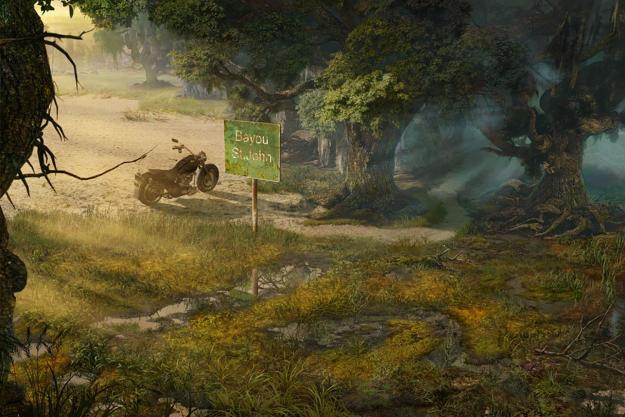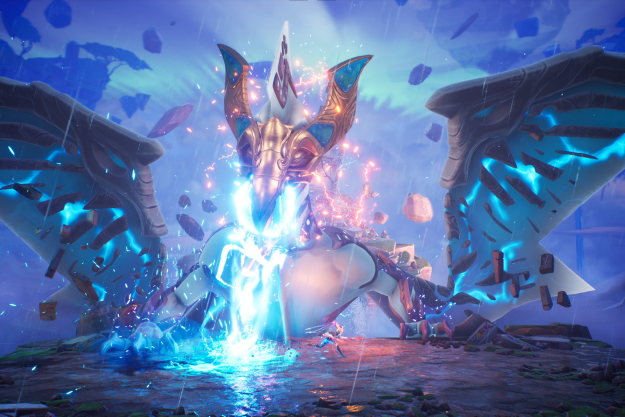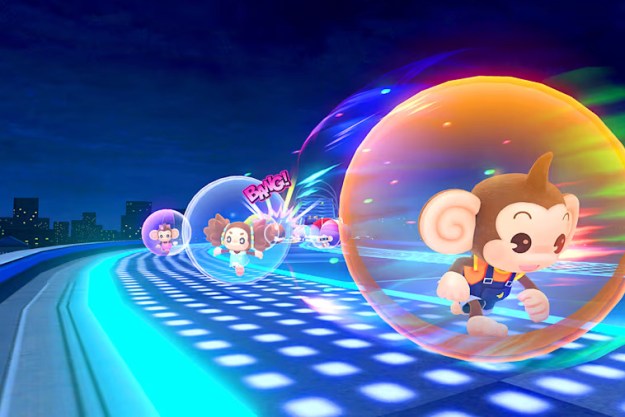
“Gabriel Knight: Sins of the Father holds up remarkably well after two decades, but loses some of its soul in this HD remake.”
- Original game’s writing and design hold up remarkably well after 20 years
- Puzzles are challenging, but not obtuse
- In-game hints are well-designed to give you just enough help
- Graphical overhaul is competent but lacking soul
- Original voice cast does not return
The eponymous Gabriel Knight is a womanizing, struggling novelist who owns a used bookstore in New Orleans’ French Quarter. He’s also the star of Gabriel Knight: Sins of the Father, the classic Sierra adventure, freshly remade for its 20th anniversary with all-new new sights and sounds. A city with a past as sordid as New Orleans is the perfect setting for a noir murder mystery, and the game still does an excellent job of capturing the Big Easy’s gritty charm.
A series of apparently ritualistic, voodoo murders plagues the city. With the help of childhood buddy, detective Mosely, and girl Friday shop assistant Grace, Gabriel looks into the murders as research for his latest crime thriller. When he meets and swoons for the beautiful socialist Malia Gedde, who seems to be somehow tied to the events, Gabriel starts slipping down a dangerous rabbit hole that brings him into New Orleans’ menacing underworld and closer to his own family’s mysterious legacy.
Gabriel’s languid drawl drips with sleazy confidence.
It’s standard film noir fare, but studied and well-executed. Writer Jane Jensen earned her chops writing adventure games like this one for Sierra during the studio’s golden age, and then went on to pen a few novels. That literary bent is apparent.
The story’s pacing is excellent, dividing the game into ten days, during which Gabriel must accomplish a few specific things before turning in for the night. Each morning, he stumbles out of his bedroom at the back of the bookstore to be greeted by Grace’s sarcastic needling and a hint-bearing daily newspaper. The game starts casually, with the first half focused on research and conversation, but as the map opens up and the action accelerates, the opportunity to make deadly mistakes presents itself more and more.
The puzzles are challenging, but rarely obtuse in the way that early adventure games are often known for. Many are conversational, simply requiring you to talk to the right people about the right topics. These feel organic and true to the spirit of a crime-investigating novelist.
The object puzzles are trickier, but the solution is usually sensible enough that you can figure it out naturally. There’s little reason to apply brute-force “adventure game logic,” the age-old process of systematically rubbing everything in your inventory on everything (and everyone) you encounter. There are a handful of very literal puzzles (sliding blocks around and the like) that feel shoehorned in, but these are few and far enough between to be forgiven.
Gabriel Knight does an excellent job of nudging you in the right direction when you need it. Your readily accessible journal continually updates with what you’ve observed so far. It also contains two levels of hints: Guiding questions for when you need a gentle nudge, and explicit answers for when you just throw your hands up. There’s also a button that slaps labels on every interactive object on the screen, an excellent touch that helps players avoid needless pixel-hunting.
The graphical overhaul is technically competent, but loses some of the soul from the original. The backgrounds are lush with detail, and the character models are well animated and lit, but there is a sterile disconnect between the two. The characters don’t appear to inhabit the environments so much as they exist on top of them. While not as marked a separation as, say, polygonal Cloud Strife strolling around the hand-painted Midgar in Final Fantasy VII, the higher resolution leads to a sort of spatial uncanny valley, leaving the world feeling a little cold, a little off.
The higher resolution leads to a sort of spatial uncanny valley, leaving the world feeling a little cold, a little off.
The original’s pixels were necessarily less detailed, but rendering characters, objects, and environment in the same system gave the game a holistic unity. That consistency, while leaving more to the imagination, led to a greater sense of immersion. The 2D/3D disconnect of the updated visuals calls attention to the game’s own artifice.
On the other hand, some elements of the visual update work quite well. The animated portraits during conversations are lively and convincing, and Gabriel no longer looks like a hung-over Conan O’Brien.
It is truly unfortunate that the original game’s star-studded voice cast – featuring the likes of Tim Curry, Mark Hamill, Leah Remini, Efrem Zimbalist, Jr. and Michael Dorn – could not transfer to the remake. The new cast at least does an admirable job of filling those shoes, however. Gabriel’s languid drawl drips with sleazy confidence. You might want to turn off the rambling narrator, though, if you hope to finish the game in this lifetime.

The score, composed by Jensen’s husband and Pinkerton Road co-founder Robert Holmes, also received an excellent makeover. The game’s soundtrack contains a few earworms that threaten to stick with you long after you stop playing.
Gabriel Knight: Sins of the Father holds up remarkably well two decades later. This new 20th Anniversary Edition stands as both a testament to the original game’s design and a challenge to modern adventure games to show that they’ve learned something substantial in the intervening years. It is not a strict improvement, however.
For gamers that can’t stomach the original’s pixels, clunkier UI, and MIDI soundtrack, then this is the perfect way to experience a classic. Fans of ’90s adventures might find the update lacking in soul, though, and are probably best off just grabbing the original from Good Old Games.
This game was reviewed on a Windows computer using a Steam code provided by
Highs
- Original game’s writing and design hold up remarkably well after 20 years
- Puzzles are challenging, but not obtuse
- In-game hints are well-designed to give you just enough help
Lows
- Graphical overhaul is competent but lacking soul
- Original voice cast does not return




